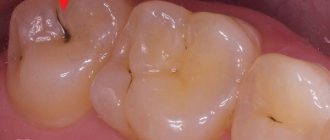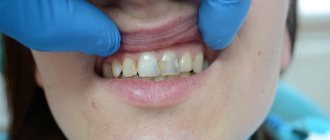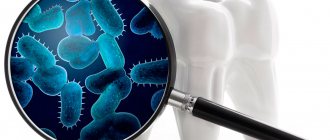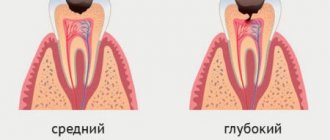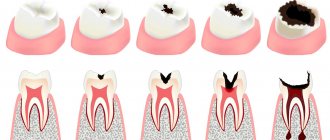Deep caries is the last stage of dental caries and is considered an advanced form of the disease. It is more difficult to treat, but even at this stage you can do without removal. Modern materials and technologies make it possible to restore a tooth while maintaining its functionality. We will tell you what methods of treating deep caries are available.
In this article
- First stage of caries
- Second stage of caries
- Middle stage of caries
- Stage four: deep caries
- How to treat deep caries
- Possible complications in the treatment of deep caries
Caries is a complex and progressive pathological process that destroys hard tooth tissue and develops as a result of exposure to internal and external factors. The direct causative agent of the disease is cariogenic microorganisms. They secrete harmful acids, which first corrode the inorganic component of the enamel, then its organic part and penetrate the dentin, forming a carious cavity. If caries is not treated, inflammatory complications arise from the pulp and periodontium.
The presence of bacteria alone is not enough for the appearance of a carious lesion, since they are present in the mouth of every person and are considered opportunistic. Under certain conditions, for example, poor hygiene, abuse of sweets or weak immunity, microbes actively multiply and wash minerals out of the enamel. This process is called demineralization. Gradually, the carious cavity spreads and covers almost all tooth tissues.
Caries can be cured at any stage, but the later the patient goes to the dentist, the more difficult the treatment process. First, we will describe the stages of development of the carious process, after which we will talk about methods of treating deep caries.
Causes of caries development
There can be many reasons for the appearance of caries, but the main one is a violation of the acid-base balance in the oral cavity, which leads to the formation of plaque. Gradually, plaque, if not removed, accumulates, penetrating the inner layers of enamel and destroying the tooth.
In turn, a violation of this balance may have the following reasons:
- poor hygiene;
- an excess of sweet and overly fatty foods in the daily diet;
- insufficient intake of vitamins (including from fresh fruits and vegetables);
- poor quality of drinking water;
- consequences of diseases suffered in childhood (for example, rickets);
- diabetes;
- dysfunction of the thyroid gland;
- gastrointestinal diseases;
- general decrease in immunity.
The answer to the question: “Is it worth treating caries?” - unambiguous. It doesn’t just need to be treated: you need to see a doctor at the first sign of its appearance. Otherwise, advanced caries can lead to severe pain and eventual tooth loss.
What are the differences from other forms of the disease?
Deep caries is very similar to some forms of the disease, but there are still visible and invisible differences.
Difference from pulpitis
Pulpitis is a complication of advanced caries. The forms of the disease can be distinguished from each other by their characteristic symptoms:
- Defeat. With pulpitis, the nerve is affected; with caries, the nerve remains unharmed.
- Feelings of pain. With pulpitis, pain can occur spontaneously, even without exposure to irritants on the tooth. With caries, pain disappears along with the disappearance of irritants.
- Night sleep. With pulpitis, sleep can be disturbed due to severe pain; with caries, the tooth does not hurt at night.
Difference from average caries
The similarity between the two forms of the disease is that the patient in both forms feels pain from cold, sour or sweet foods. However, with average caries they go away within 1-2 minutes, with deep caries they last longer.
Medium caries is characterized by the fact that in this form the carious lesion does not affect the tooth pulp and does not cause inflammation of the nerve, as in deep caries.
Factors provoking the development of caries
In addition to the above reasons, caries can be caused by:
- anatomical features of the structure of teeth (congenital dimples in the enamel in which plaque accumulates);
- malocclusion (crooked teeth lead to the fact that even good toothpaste and a high-quality brush are not able to fully cope with cleansing);
- increased viscosity of saliva (renewal of microflora does not occur properly due to this, resulting in various diseases);
- a state of constant stress and increased nervousness (this leads to a deterioration in the absorption of microelements from food).
Treatment of dental caries and its features
The stage of development of carious formation directly affects the complexity of treatment.
- Caries in the spot stage, when areas of white and less often dark color are noticeable on the enamel, but the enamel itself is not damaged. A change in color indicates a loss of calcium in the area where the stain appeared. This is the simplest form of carious formation, which does not even require drilling. To correct the situation, a remineralization procedure is necessary - sometimes the patient can do it on his own at home.
- Superficial caries, in which the defect is located within the enamel layer, without affecting deeper layers. Here you cannot do without standard filling.
- Medium form, characterized by caries extending beyond the boundaries of the enamel and damage to the upper part of the dentin.
- Deep form , when the disease penetrates into the deep layers, sometimes involving the pulp. As a rule, it is accompanied by pain. This is the most advanced case, so a patient who did not go to the clinic on time and reached this stage will be forced to be treated in several stages. Treatment of deep caries requires separate consideration, as it is the most complex.
In addition, there is also bottle caries in children , the treatment of which has its own characteristics, since it affects only the upper incisors.
How dental caries is treated with laser
In addition to the traditional treatment of caries, modern medicine offers an innovative method using a laser.
Using a laser you can:
- selectively remove affected tissue, preserving healthy tissue as much as possible;
- sterilize the canals, which is necessary in the treatment of pulpitis.
Among the advantages of the laser:
- high quality of treatment;
- no pain;
- longevity of the results obtained;
- complete safety for the patient;
- no discomfort during the treatment process.
The laser allows you to achieve the formation of a completely sterile cavity and avoid chips and cracks, which often happens when using a drill. The surface of the tooth becomes like pumice, which has a positive effect on the properties of the materials used for filling.
Stage four: deep caries
With deep caries, the tooth is destroyed by at least ⅓. Only a thin partition of dentin protects the pulp from caries. There is a risk that bacteria will spread to soft tissues and inflammation will begin - pulpitis. A tooth can break into pieces at any time. The patient almost constantly experiences discomfort and pain: while eating, brushing teeth, drinking, etc. If soft tissues become inflamed, the pain is prolonged and radiates to the temple or ear. In this case, painkillers hardly help.
Deep caries can occur in acute or chronic form. In the first case, it develops rapidly, quickly spreading through hard tissues. The disease is accompanied by severe pain, especially while eating. Lack of treatment leads to pulpitis and periodontitis.
Chronic deep caries proceeds sluggishly. Pain sensations are disturbing, but much less frequently than during an exacerbation, and not with such intensity. This is due to the fact that at the bottom of the carious cavity, replacement tissues are formed that protect the pulp from external irritants. Despite this protective barrier, the pathological process continues to destroy dentin.
Deep caries can be primary or secondary. The first develops on a healthy tooth, and the second - under a filling. Let's consider methods of treating caries at the fourth stage.
How caries is treated with the ICON system
This is another modern technology that allows minimal use of medical instruments: in rare cases, the doctor uses a drill, but in most situations it is possible to use a hand instrument, which preserves the maximum possible volume of natural tooth tissue.
In addition, the ICON system has the following advantages:
- no need for pain relief;
- healthy dentin is not damaged during treatment;
- the procedure lasts no more than 45 minutes, there are no age restrictions.
How to treat dental caries using the ICON system:
- soft tissues are isolated with a rubber dam;
- the affected area is treated with a special gel;
- the carious area is cleaned with a medical instrument;
- a gel is applied, popularly called a “liquid filling”;
- the composition is fixed using ultraviolet light;
- The surface of the tooth is polished.
But the procedure also has a minus, otherwise it would be used everywhere: this method can only be used at the initial stage of caries development, but for deeper lesions you cannot do without a drill.
Characteristics of the method
The use of devices that allow magnification of images of the operating area provides doctors with significant advantages in medicine.
It becomes possible to assess the condition of each tooth and perform complex manipulations, controlling every movement. Key factors that improve the quality of dental treatment and prosthetics: multiple magnification , good lighting , accurate and convenient positioning of the microscope.
In dental treatment, special dental microscopes are used - electronic optical devices that can magnify images 30 times or more. The microscope is brought to the surgical field using a pantograph, which in turn is attached in various ways: floor (bed), wall (brackets), ceiling; Thanks to the mechanism, the microscope easily takes the exact position above the tooth and is fixed in it. The microscope is equipped with a digital camera connection, which can be used to take photographs and record videos. An image of the treatment process is displayed on the monitor so that the assistant, whose presence is required, can navigate the doctor’s actions. Some devices are equipped with a monocular or binocular tube for an assistant to monitor the progress of treatment.
During treatment using a microscope, the patient is in a chair in the “lying” position, and a microscope lens is installed over the tooth being treated. The doctor sits behind the patient's head or to his right and conducts treatment through eyepieces. The assistant gives the dentist the necessary instruments. For the doctor who conducts treatment under a microscope, a work chair with special armrests and lumbar support is provided - this is necessary so that during long procedures the dentist does not get tired of sitting and there is no hand trembling.
Treatment of caries on baby teeth
Many parents, having noticed caries on their child’s baby teeth, believe that nothing needs to be done - these teeth will fall out anyway. However, such a decision is explained by ignorance: not every person knows what kind of caries is treated in modern dental clinics.
When visiting a doctor, a child undergoes:
- ozone therapy is a modern method using a powerful jet of ozone used for antibacterial treatment;
- infiltration is a method in many ways similar to ICON, but a filling is not installed (the doctor is limited to isolating the cavity);
- abrasive cleaning - the method is suitable for the initial stage of caries, has many similarities with professional cleaning of the oral cavity;
- silvering - the enamel is coated with a solution of silver diamine, which disinfects the surface. The method is rarely used due to its low aesthetic appeal - teeth remain black until they fall out;
- Conservative treatment for more serious lesions, accompanied by pain relief.
Types of plaque
Surely many are familiar with this problem and have searched the Internet for information on how to remove plaque on teeth. It comes in different types - both colorless and pigmented.
✔ White, creamy, yellowish coating.
Such deposits form during sleep in conditions of poor nutrition and poor hygiene.
✔ Gray.
Associated with impaired mineralization of enamel, leading to its hypoplasia.
✔ Green.
Plaque on the front teeth of children and adults, the formation of which is caused by the activity of bacteria containing chlorophyll.
✔ Yellow
- plaque from tea on the teeth, from nicotine, food coloring, and also appears with age.
✔ Brown.
Often found in smokers and those who have amalgam fillings. People whose profession involves the manufacture of metal products from copper, brass and bronze are also at risk. In children, the formation of such plaque is observed when a large amount of unreduced iron is excreted with saliva.
✔ Black (Priestley's touch).
Black or dark brown spots on the inner and outer surfaces of baby teeth occur when pigment-forming bacteria are activated in the child’s mouth.
Treatment of average caries in stages
Step-by-step treatment of caries includes the following steps:
- Cleaning the surface from plaque . How are caries treated in dentistry? First, be sure to clean the damaged tooth and the teeth adjacent to it. To remove plaque, the dentist can use an abrasive brush or floss; to remove the stone, ultrasonic attachments will be required.
- Drilling out affected tissues . Since enamel is hard and durable, it is destroyed less than dentin. It is for this reason that the entrance hole of the cavity may be small, expanding as it deepens. If cervical caries occurs, how to treat it? The doctor drills the edges of the enamel and removes dentin affected by caries. If even a small area of affected tissue remains, on top of which a filling is placed, this is fraught with problems in the very near future, because caries will begin to develop rapidly, which can ultimately lead to pulpitis.
- Isolating the tooth from moisture and saliva . Unfortunately, some dentists (in fact, most of them) neglect this point and skip it. When carious tissue is eliminated, the doctor, in preparation for filling, must isolate the tooth from contact with saliva. It might seem like a small thing, but it affects how long the filling will last. For a long time, ordinary cotton wool or gauze was used for isolation, which was used to cover the tooth, but this method was found to be ineffective. Modern dentistry recommends the use of rubber dam - a thin latex material in which holes are made. Its installation is quite labor-intensive, so dentists avoid this procedure in order to save their own time. The use of a rubber dam by a doctor is a sign that the dentist is conscientious about his work, putting the patient’s health above the profit received.
- Treatment of the cavity with antiseptics.
- Recreating the side wall . How is caries treated if it has affected the surface of the tooth in contact with another tooth nearby? Then you will need to install matrices and wedges to restore the side wall. The procedure cannot be called simple.
- Using acid to condition enamel . To ensure that the adhesive material applied to dentin penetrates into the deep tissues, phosphoric acid is used. At the end of the procedure, the gel must be completely washed off and the surface dried.
- Treatment of enamel with adhesive . In order to ensure ideal fastening of the filling, the enamel is thoroughly impregnated with adhesive material, and after its absorption, it is illuminated with a polymerization lamp.
- Installing a gasket for a seal . A gasket made of a special material is placed at the bottom of the drilled cavity. The need for this action is explained by the peculiarity of the shrinkage mechanisms of the filling material.
- Direct filling , restoring chewing function and aesthetic appearance. To do this, photopolymer materials are laid layer by layer, with each layer illuminated by a lamp, which gives greater strength.
- Surface grinding and polishing . Immediately after installation, the filling is uneven, as a result of which it not only causes a feeling of discomfort, but can even damage the tongue. Polishing will make the tooth smooth.
For many people, it is important not only to undergo caries treatment in Krasnodar, getting rid of pain and discomfort, but also to look attractive. Therefore, the dentist selects the filling material by color, trying to achieve 100% shade similarity with the natural tissue of neighboring teeth. The doctor’s task is to make sure that the filling does not stand out from the rest of the teeth, which is especially important when smiling.
Is it possible to treat caries on the front teeth without pain? Absolutely yes. Long gone are the days when going to the dentist and the treatment process was accompanied by physical suffering. Modern means of anesthesia make it possible for the patient to feel nothing at all. The anesthesiologist is able to select the concentration of the anesthetic so that it will act for several hours. The only unpleasant moment is the insertion of a needle into the gum: the faster the drug enters the tissue, the more painful it is for the patient. Although much here depends on the characteristics of the nervous system of each individual person. For people with a high pain threshold, going to the dentist can be an enjoyable experience.
Preventive measures against caries
Any disease is easier to prevent than to treat, and caries is no exception in this regard.
To avoid its appearance, you need to:
- brush your teeth twice a day for 2 minutes;
- do not use toothpicks - special dental floss is more suitable for high-quality cleaning;
- use an irrigator or mouthwash;
- get rid of bad habits (smoking and drinking alcohol provoke deterioration of the oral cavity);
- eat more calcium in food;
- Get checked by a dentist at least once a year, but it’s better to do it more often.
| We must not forget that the main reason for the formation and development of caries is lack of hygiene. Therefore, prevention is extremely important, which consists of regular high-quality brushing of teeth after each meal. |


